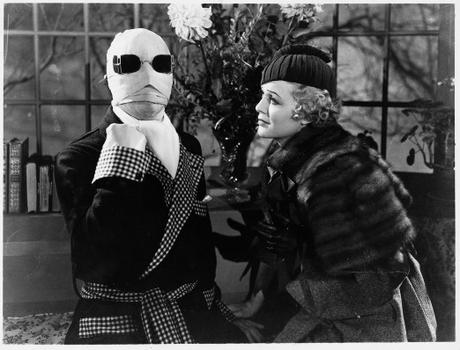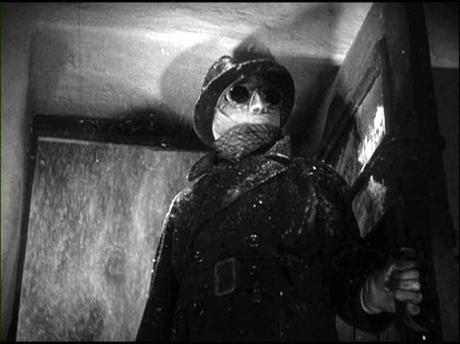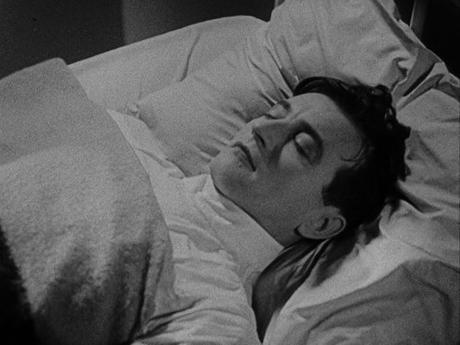 Jack Griffin (Claude Rains) explains his worldview to Flora (Gloria Stuart) in James Whales’ The Invisible Man (1933)
Jack Griffin (Claude Rains) explains his worldview to Flora (Gloria Stuart) in James Whales’ The Invisible Man (1933)A solitary figure toting a large suitcase is seen braving the English countryside’s wintry weather. He hesitates for a moment before entering the Lion’s Head Inn in the village of Ipping. Upon opening the door, he startles a group of patrons inside with his peculiar looks and detached deportment. They recoil from him as he slowly approaches the bar.
Sporting dark goggles, a false nose, and a thoroughly bandaged head, the visitor insists to the innkeeper, Mr. Hall, on renting a room. “I want to be left alone, and undisturbed,” he later intones. If curiosity killed the cat, it certainly had a similar effect on the villagers, who gossip among themselves about the visitor’s secretive ways.
Bursting in unexpectedly on the stranger as he’s having his supper, the proprietress of the inn, Jenny Hall, makes note of an unusual facial feature: there’s nothing there expect empty space! “He must’ve been in some horrible accident,” she mutters.
A week goes by and the stranger continues to hole up in his room. In fact, he’s transformed the space into a chemist’s laboratory! Some humorous asides ensue between Mr. and Mrs. Hall. She insists that her husband take up the overdue bill, but he hesitates. “Let him cool off first,” he suggests. Nothing doing! She gives her husband an ultimatum: either the stranger goes or she goes.

Mr. Hall rudely interrupts the stranger and tells him to pack up his belongings and get out. Pleading with the man that he’s the victim of an unfortunate accident, Griffin begs to be left alone. But his pleas fall on deaf ears. Unfortunately for Mr. Hall, the stranger throws the poor man down a flight of stairs. This drives the proprietress Mrs. Hall to a fit of hysterics as the other patrons go in search of a policeman.
It soon becomes apparent that the stranger, whose name is Dr. Jack Griffin, has a deeper affliction: a chemist by profession, Griffin has been searching in vain for a way back from his invisibility.
Although Boris Karloff was originally touted to star (he turned down the part of Griffin due to salary issues and the lack of “screen presence”), the 44-year-old British actor Claude Rains made a successful first impression on audiences in his American motion picture “debut” (in a manner of speaking) with this fascinating film version of H.G. Wells’ 1897 science fiction novella.
The Invisible Man is the ultimate mad-scientist-on-the-loose epic to end all epics, with enough megalomaniacal dialog (“Power to rule, to make the world grovel at my feet!” and “We’ll start with a few murders. Big men, little men — just to show we make no distinction!”) and ironic twists of dark humor (“Here we go gathering nuts in May on a cold and frosty morning!”) to satisfy any sci-fi addict.
What made this feature so great, after all, were the astounding special effects for the period (the work of FX specialist John P. Fulton, along with John J. Mescall and Frank D. Williams), painstakingly done with plaster models, mattes, process photography, and double exposures. There were times when the lead actor had to dress from head to toe in thick, black velvet, as well as endure being smothered in plaster casts, in order for the invisibility effect to register on film. When Rains, as Dr. Griffin, takes off the bandages that bind his head and face, he reveals … absolutely nothing. Top that, Industrial Light and Magic!
There are innumerable feats of legerdemain throughout the production, but none of them could stand a ghost of a chance at sci-fi posterity were it not for Rains’ unequalled vocal performance. By voice and body alone, Rains managed to do the impossible by investing the character of the ambitious scientist, on the verge of an earth-shattering discovery, with a huge measure of sympathy for his plight.
Griffin is our modern-day Dr. Frankenstein (and part Mummy), with one major difference: he’s experimented on himself instead of a test subject. His inability to undo what he has wrought brings about his transformation into a murderous, power-hungry fiend, obsessed with wielding his dictatorial rule over mankind to the detriment of those he holds most dear.
So pitifully poor in wealth and background, Griffin had nothing to offer his sweetheart, Flora Cranley. That is, until he stumbled upon the formula that would alter his universe: a powerful mind-altering drug called monocaine (a possible pseudonym for morphine), which renders the subject invisible while leaving behind a warped personality.
His scenes with the desperate Flora are pitiable in their futility: she realizes he has gone completely insane, but is helpless to dissuade him from his murderous path; while he can only rock back and forth in his chair, seeking solace and relief where none can be had. Grasping at his forehead, Griffin mouths his contempt for humanity and its weaknesses. He is incapable of accepting the truth of what Flora reveals, that the drug has altered his soul and his being. Won’t he let her father help him? Not a chance!
Griffin goes on a murder spree, first throttling a policeman to death, next sabotaging a speedy train, and then sending his former assistant Kemp over the side of cliff for betraying him to the police. In the end, alone and doomed by his lust for power, Griffin is shot and captured by his pursuers. On his deathbed, the invisibility begins to fade, revealing the real man behind the bandages: calm, serene, and finally at rest.

Directed by James Whale, who also worked on the previous Universal hit Frankenstein (1931), the film was another of the studio’s highpoints in the expanding list of classic monster movies. Whale pointed his camera high above the ceiling for the scene where the British bobby (E.E. Clive) and townspeople climb the stairs to Griffin’s room. For others, he kept the camera low to the ground which made Griffin loom physically large and menacing (Rains was famously short of stature), as well as rail from on high about conquering the world. Less dependent on the techniques of German Expressionism than either Frankenstein (1931) or its sequel, The Bride of Frankenstein (1935), The Invisible Man spawned numerous sequels and imitators, none of which scaled the heights of the original.
Produced by Carl Laemmle Jr., it co-starred the lovely Gloria Stuart (The Old Lady in James Cameron’s Titanic) as Griffin’s fiancée Flora, William Harrigan as his treacherous assistant Dr.Kemp, and Henry Travers as Flora’s father and Griffin’s employer, Dr. Cranley, along with Una O’Connor as Jenny Hall, Forrester Harvey as Herbert Hall, Dudley Diggs as the Chief Detective, and E.E. Clive as Constable Jaffers. Others in the cast include the dependable Dwight Frye as a reporter, John Carradine (under the pseudonym Peter Richmond), and Walter Brennan. The screenplay is credited to R.C. Sheriff.
Copyright © 2017 by Josmar F. Lopes
Advertisements
